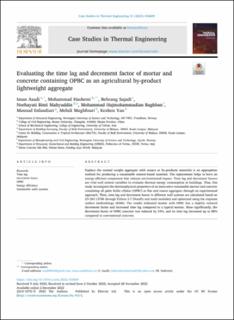| dc.contributor.author | Asadi, Iman | |
| dc.contributor.author | Hashemi, Mohammad | |
| dc.contributor.author | Sajadi, Behrang | |
| dc.contributor.author | Mahyuddin, Norhayati Binti | |
| dc.contributor.author | Haj Mohammadian Baghban, Mohammad | |
| dc.contributor.author | Esfandiari, Masoud | |
| dc.contributor.author | Maghfouri, Mehdi | |
| dc.contributor.author | Yan, Kezhen | |
| dc.date.accessioned | 2023-05-23T11:22:41Z | |
| dc.date.available | 2023-05-23T11:22:41Z | |
| dc.date.created | 2023-03-14T13:34:14Z | |
| dc.date.issued | 2023 | |
| dc.identifier.issn | 2214-157X | |
| dc.identifier.uri | https://hdl.handle.net/11250/3068669 | |
| dc.description.abstract | Replace the normal weight aggregate with wastes or by-products materials is an appropriate method for producing a sustainable cement-based material. The replacement helps to have an energy-efficient component that reduces environmental impact. Time lag and decrement factors are vital wall system variables to evaluate thermal energy consumption in buildings. Thus, this study investigates the thermophysical properties of an innovative sustainable mortar and concrete containing oil palm boiler clinker (OPBC) as fine and coarse aggregate through an experimental approach. Then, time lag and decrement factor in different wall systems are calculated based on EN ISO 13786 through Python 3.7 (NumPy and math modules) and optimized using the response surface methodology (RSM). The results indicated mortar with OPBC has a slightly reduced decrement factor and increased time lag compared to a typical mortar. More significantly, the decrement factor of OPBC concrete was reduced by 34%, and its time lag increased up to 58% compared to conventional concrete. | en_US |
| dc.language.iso | eng | en_US |
| dc.publisher | Elsevier B. V. | en_US |
| dc.rights | Navngivelse 4.0 Internasjonal | * |
| dc.rights.uri | http://creativecommons.org/licenses/by/4.0/deed.no | * |
| dc.title | Evaluating the time lag and decrement factor of mortar and concrete containing OPBC as an agricultural by-product lightweight aggregate | en_US |
| dc.title.alternative | Evaluating the time lag and decrement factor of mortar and concrete containing OPBC as an agricultural by-product lightweight aggregate | en_US |
| dc.type | Peer reviewed | en_US |
| dc.type | Journal article | en_US |
| dc.description.version | publishedVersion | en_US |
| dc.source.volume | 41 | en_US |
| dc.source.journal | Case Studies in Thermal Engineering | en_US |
| dc.identifier.doi | 10.1016/j.csite.2022.102609 | |
| dc.identifier.cristin | 2133837 | |
| dc.source.articlenumber | 102609 | en_US |
| cristin.ispublished | true | |
| cristin.fulltext | original | |
| cristin.qualitycode | 1 | |

